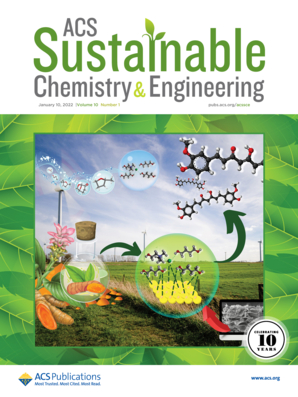Development of Advanced Activated Biocarbon from Corn Distiller Soluble via Two-Step Carbonization: Investigating the Synergistic Effects of ZnO and K toward Enhanced CO2 Capture
IF 7.1
1区 化学
Q1 CHEMISTRY, MULTIDISCIPLINARY
引用次数: 0
Abstract
The excessive emissions of CO2 into the atmosphere have a severe impact on the ecological environment. Activated carbon (AC) offers a promising strategy for cost-effective carbon dioxide (CO2) emissions mitigation as a solid adsorbent. The chemical activation process, which involves direct mixing of an activating agent with biomass, is a common method to achieve a porous morphology and high surface area in AC. Herein, an advanced and highly microporous activated biocarbon was synthesized using a two-step carbonization process consisting of hydrothermal synthesis of the ZnO/C carbon precursor based on condensed corn distiller soluble (CDS) followed by potassium hydroxide (KOH) activation at 700 °C for 60 min. The results indicated that the synergistic use of ZnO and K plays a complementary role in structural development and functional enhancement. This synthesis strategy resulted in advanced activated biocarbon with a significantly higher surface area of 1744.6 m2 g–1, outperforming biocarbon activated with KOH alone. In this study, it was hypothesized that KOH would penetrate and activate the ZnO/C carbon precursor more effectively than the direct activation of CDS. The resulting advanced activated biocarbon materials were systematically investigated through comprehensive microstructural, physicochemical, interfacial, textural, and thermal analyses. Scanning electron microscopy (SEM) revealed a superior 3D hierarchical structure enriched with micropores, favorable mesopores, and interconnected macropores of synthesized biocarbon. Furthermore, CO2 adsorption capacities were performed at various temperatures (273, 288, 298, and 308 K). The highest adsorption capacities, ranging from 3.70 to 6.30 mol kg–1, were observed at 1 bar and 273 K for all advanced activated biocarbon samples. Notably, the combined catalytic and templating effects of ZnO and K resulted in a highly porous structure with a high surface area, abundant adsorption sites, and excellent selective CO2 capture properties.

求助全文
约1分钟内获得全文
求助全文
来源期刊

ACS Sustainable Chemistry & Engineering
CHEMISTRY, MULTIDISCIPLINARY-ENGINEERING, CHEMICAL
CiteScore
13.80
自引率
4.80%
发文量
1470
审稿时长
1.7 months
期刊介绍:
ACS Sustainable Chemistry & Engineering is a prestigious weekly peer-reviewed scientific journal published by the American Chemical Society. Dedicated to advancing the principles of green chemistry and green engineering, it covers a wide array of research topics including green chemistry, green engineering, biomass, alternative energy, and life cycle assessment.
The journal welcomes submissions in various formats, including Letters, Articles, Features, and Perspectives (Reviews), that address the challenges of sustainability in the chemical enterprise and contribute to the advancement of sustainable practices. Join us in shaping the future of sustainable chemistry and engineering.
 求助内容:
求助内容: 应助结果提醒方式:
应助结果提醒方式:


